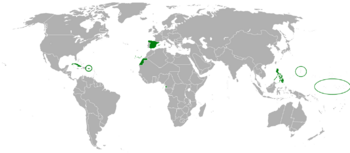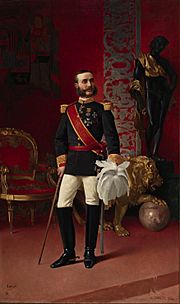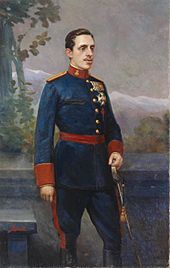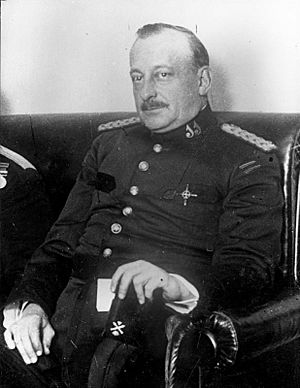Restoration (Spain) facts for kids
Quick facts for kids
Kingdom of Spain
Reino de España (Spanish)
|
|||||||||
|---|---|---|---|---|---|---|---|---|---|
| 1874–1931 | |||||||||
|
Motto: Plus Ultra
"Further Beyond" |
|||||||||

The Kingdom of Spain and its colonies in 1898
|
|||||||||
| Capital | Madrid | ||||||||
| Common languages | Spanish | ||||||||
| Religion | Roman Catholicism (state religion) | ||||||||
| Demonym(s) | Spanish, Spaniard | ||||||||
| Government | Unitary parliamentary constitutional monarchy
|
||||||||
| King | |||||||||
|
• 1874–1885
|
Alfonso XII | ||||||||
|
• 1886–1931
|
Alfonso XIII | ||||||||
| Regent | |||||||||
|
• 1885–1902
|
Maria Christina | ||||||||
| Prime Minister | |||||||||
|
• 1874–1875 (first)
|
Antonio Cánovas | ||||||||
|
• 1931 (last)
|
Juan B. Aznar | ||||||||
| Legislature | Cortes Generales | ||||||||
| Senate | |||||||||
| Congress of Deputies | |||||||||
| History | |||||||||
|
• Pronunciamiento
|
29 December 1874 | ||||||||
| 30 June 1876 | |||||||||
| 25 Apr–12 Aug 1898 | |||||||||
|
• Melilla War
|
1909–1910 | ||||||||
|
• Pact of San Sebastián
|
17 August 1930 | ||||||||
| 14 April 1931 | |||||||||
| Currency | Spanish peseta | ||||||||
|
|||||||||
The Restoration (Spanish: Restauración), or Bourbon Restoration (Spanish: Restauración borbónica), is the name given to the period that began on 29 December 1874—after a coup d'état by General Arsenio Martínez Campos ended the First Spanish Republic and restored the monarchy under Alfonso XII—and ended on 14 April 1931 with the proclamation of the Second Spanish Republic.
After almost a century of political instability and many civil wars, the aim of the Restoration was to create a new political system, which ensured stability by the practice of turnismo. This was the deliberate rotation of the Liberal and Conservative parties in the government, often achieved through electoral fraud. Opposition to the system came from Republicans, socialists, anarchists, Basque and Catalan nationalists, and Carlists.
The period of Restoration in Spain, from 1874 to 1931, was marked by political instability, economic struggles, and social unrest. Here are some of the main themes that shaped this era in Spanish history:
- Political conservatism: The Restoration period was characterized by a return to conservative politics and the re-establishment of the Bourbon monarchy. King Alfonso XII was able to restore stability to the country after years of political turmoil and upheaval. However, this stability was often maintained through repression and the suppression of dissent.
- Economic struggles: Spain experienced economic struggles during the Restoration period, including high levels of unemployment and inflation. There was also a high level of social inequality, with a small wealthy elite controlling most of Spain's resources.
- Social unrest: The period was marked by social unrest and the rise of socialist and anarchist movements. These movements sought to end the economic and social inequalities that existed in Spanish society and often clashed with the conservative government.
- Regional tensions: Spain has a long history of regional tensions, and these tensions were heightened during the Restoration period. There were many movements calling for greater autonomy for regions such as Catalonia and the Basque Country.
- The Spanish-American War: In 1898, Spain lost nearly all of its few remaining colonies in the Spanish-American War, including Cuba, Puerto Rico, and the Philippines. This was a major blow to Spanish pride and had a significant impact on the country's economy and politics.
- Cultural revival: Despite the political and economic challenges of the Restoration period, it was also a time of cultural revival in Spain. There was a renewed interest in Spanish art, literature, and music, and many important cultural figures emerged during this time.
Contents
Alfonso XII and the Regency of Maria Christina (1874–1898)
On 29 December 1874, the pronunciamiento by General Arsenio Martínez Campos overthrew the First Spanish Republic and restored the monarchy, with Alfonso XII (son of the exiled Isabella II) as king. After this, the Constitution of 1876 was written and enforced during the whole restoration. This constitution established Spain as a constitutional monarchy with a bicameral legislature (Cortes Generales), consisting of an upper house (Senate), and a lower house (Congress of Deputies). This constitution gave the King the power to name Senators and to revoke laws if he wanted to, and he was also given the title of Commander-in-chief of the army.
These years were marked by economic prosperity. Ever since the end of the Napoleonic Wars in 1815, Spain's economy had fallen even further behind those of other European countries. During these years the modernization of the country took place on a large scale. On most fronts domestic production was increased, supported by extreme protectionist measures.
The two parties alternated in the government in a controlled process known as el turno pacífico; the Liberal Party was led by Sagasta and the Conservative Party by Canovas del Castillo. The caciques, powerful local figures, were used to manipulate election results, and as a result resentment of the system slowly built up over time and important nationalist movements in Catalonia, Galicia and the Basque Country, as well as unions, started to form.
Alfonso XII died in November 1885 because of a recurrence in dysentery. His wife Maria Christina was still pregnant of his son Alfonso XIII, who was born on 17 May 1886 and became King upon birth; a regency was formed, led by Queen Mother Maria Christina.
Reign of Alfonso XIII and crisis of the system (1898–1923)
In 1898, Spain lost its last major overseas colonies (Cuba, Guam, Puerto Rico, and the Philippines) in the Spanish–American War. The rapid collapse was perceived as a disaster in Spain, undermining the credibility of both the government and its associated ideologies and almost leading to a military coup d'état led by General Camilo García de Polavieja. This was the start of the system's decline, giving energy to all manner of conflicting opposition movements at a local and national level.
Alfonso XIII came of age in May 1902 and was enthroned on 17 May 1902, ending the regency of the Queen Mother.
Spain would begin to rehabilitate internationally after the Algeciras Conference of 1906. In 1907 it signed a kind of defensive alliance with France and the United Kingdom, known as the Pact of Cartagena in case of war against the Triple Alliance. Spain improved economically due to its neutrality in the First World War. Spanish flu killed 200,000 Spaniards (1% of the population).
The failed attempts to conquer Morocco (Melilla War) caused great discontent at home and ended in a revolt in Barcelona, known as the Semana Tragica, in which the lower classes of Barcelona, backed by the anarchists, communists, and republicans, revolted against what they considered the unjust methods for recruiting soldiers. The government declared a state of war and sent the army to crush the revolt, causing over a hundred deaths and the execution of Francisco Ferrer. The socialist Unión General de Trabajadores (UGT) and the anarchist Confederación Nacional del Trabajo (CNT) decided to initiate a general strike across the country, but it failed because the unions could only mobilize urban workers.
The problems in Morocco worsened as an army of natives attacked the Spanish army. They achieved surprise and, due to the skill of the Moroccan chieftain, Abd-Al-Krim, virtually annihilated the Spanish army, advancing almost as far as Melilla in the Battle of Annual. This Spanish defeat was due to improper planning and was blamed on the top military officers, causing great discontent among the military, who felt misunderstood, because they had been directed to advance into the interior without adequate resources to occupy the difficult territory.
Dictatorship of Primo de Rivera (1923–1930)
The military discontent, the fear of anarchist terrorism or a proletarian revolution, and the rise of nationalist movements ultimately caused great agitation amongst the civilians and the military. On 13 September 1923, Miguel Primo de Rivera, Captain General of Catalonia, orchestrated a coup d'état and deposed Prime Minister Manuel García Prieto, after issuing a manifesto blaming the problems of Spain on the parliamentary system. Alfonso XIII backed the General and named him Prime Minister. Primo de Rivera proceeded to suspend the Constitution and assume absolute powers as a dictator. He created the Unión Patriótica Española, which was meant to be the sole legal party, abolishing all other parties. During this time, he greatly increased government spending on business and public services, which caused his government to go bankrupt. He lost the support of the military and faced serious health problems. Opposition to his regime was so great that Alfonso XIII stopped supporting him and forced him to resign in January 1930.
Final year (1930–1931)
Alfonso XIII, in an attempt to return gradually to the previous system and restore his prestige, called on General Dámaso Berenguer to form a government. This failed utterly, as the King was considered a supporter of the dictatorship, and more and more political forces called for the establishment of a republic. Berenguer resigned and the King gave the government to Admiral Juan Bautista Aznar. Aznar called for local elections on 12 April 1931 in order to satisfy the democrats and republicans, to replace the dictatorship's local governments and to gradually re-introduce the restoration.
Although the monarchists had not lost all their support, the republican and socialist parties won an overwhelming victory. Street riots ensued, calling for the removal of the monarchy. The army declared that they would not defend the King and on 14 April he fled Spain. The Second Spanish Republic was immediately established under a provisional government led by Niceto Alcalá-Zamora.
Sources
- Barton, Simon. A History of Spain (2009) excerpt and text search
- Beck, Earl Ray. Time of Triumph & Sorrow: Spanish Politics during the Reign of Alfonso XII, 1874–1885 (1979)
- Ben-Ami, Shlomo. "The Dictatorship of Primo de Rivera: A Political Reassessment," Journal of Contemporary History, Jan 1977, Vol. 12 Issue 1, pp 65–84 in JSTOR
- Carr, Raymond, ed. Spain: A History (2001) online
- Esdaile, Charles J. Spain in the Liberal Age: From Constitution to Civil War, 1808–1939 (2000) excerpt and text search
- Hall, Morgan C. "Alfonso XIII and the Failure of the Liberal Monarchy in Spain, 1902–1923" (PhD dissertation, Columbia University; ProQuest Dissertations Publishing, 2003. 3095625)
- Luengo, Jorge, and Pol Dalmau. "Writing Spanish history in the global age: connections and entanglements in the nineteenth century." Journal of global history 13.3 (2018): 425–445. DOI: https://doi.org/10.1017/S1740022818000220
- Payne, Stanley G. A History of Spain and Portugal. Vol. 2 After 1700 (1973) pp 488-512, 578-629. online
- Payne, Stanley G. "Spanish Conservatism 1834–1923," Journal of Contemporary History, Vol. 13, No. 4, (Oct. 1978), pp. 765–789 in JSTOR
- Winston, Colin M. "The Proletarian Carlist Road to Fascism: Sindicalismo Libre," Journal of Contemporary History Vol. 17, No. 4 (Oct., 1982), pp. 557–585 in JSTOR
See also
 In Spanish: Restauración borbónica en España para niños
In Spanish: Restauración borbónica en España para niños






